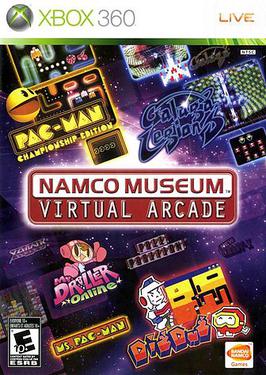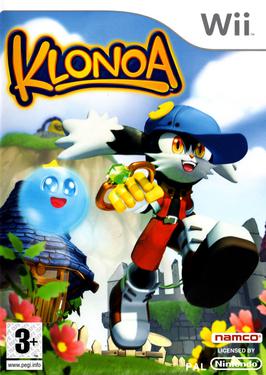
Namco Limited was a Japanese multinational video game and entertainment company founded in 1955 which operated video arcades and amusement parks globally, produced video games, films, toys, and arcade cabinets. They were one of the most influential figures in the worldwide coin-op and arcade game industry; Namco produced several multi-million-selling game franchises, such as Pac-Man, Galaxian, Tekken, Tales, Ridge Racer, and Ace Combat. In 2006, Namco merged with Bandai to form what is now named Bandai Namco Holdings; the standalone Namco brand continues to be used for video arcade and other entertainment products by the group's Bandai Namco Amusements division.

Mr. Driller is a puzzle video game franchise created by Yasuhito Nagaoka and Hideo Yoshizawa for Namco. The eponymous first game was released in 1999 for arcades and several home consoles, such as the PlayStation. Gameplay in the series consists of controlling Susumu Hori, the titular Mr. Driller, or one of his friends and destroying colorful formations of blocks to make it to the bottom of a well. In order to survive, players need to collect air capsules to replenish their depleting oxygen and avoid being crushed by falling blocks.

Klonoa is a platform video game series created by Namco in 1997. It stars Klonoa, an anthropomorphic creature who explores dream worlds. The series includes two main games: Klonoa: Door to Phantomile (1997) for the PlayStation and Klonoa 2: Lunatea's Veil (2001) for the PlayStation 2. A remake of Door to Phantomile was released for the Wii in 2008, and remasters of both games were released in 2022. The series also includes a set of handheld games released between 1999 and 2002 for the WonderSwan and Game Boy Advance.
Namco Museum is a series of video game compilations developed and published by Bandai Namco Entertainment for home video game consoles. The first title in the series, Namco Museum Vol. 1, was released for the PlayStation in 1995. Entries in the series have been released for multiple platforms, including the Game Boy Advance, PlayStation 2, PlayStation Portable, Nintendo DS and Xbox 360. the latest being Namco Museum Archives Vol. 2, released in 2020.

Pac-Man World is a platform video game developed and published by Namco for the PlayStation. Controlling Pac-Man, the player must complete each of the game's six worlds by collecting keys to free his captive family members, and reaching the end of each stage. The plot follows Pac-Man's enemies, the ghosts, crashing his 20th birthday and kidnapping his friends and family to bring them to their homeland of Ghost Island — with his birthday in ruins and his family in trouble, Pac-Man sets out to rescue them and defeat the ghosts.

Metro-Cross is a platform game released in arcades by Namco in 1985. It was ported to the Amstrad CPC, Atari ST, Commodore 64, Family Computer, and ZX Spectrum.

Klonoa: Door to Phantomile is a platform game developed and published by Namco for the PlayStation in 1997 and the first game in the Klonoa series. The story follows Klonoa and his friend Huepow in their efforts to save the dream world of Phantomile from an evil spirit intent on turning it into a world of nightmares. The player controls Klonoa through a 2.5D perspective; the stages are rendered in three dimensions but the player moves along a 2D path. Klonoa can grab enemies and throw them as projectiles, or use them as a jump boost to navigate through the stages.
Hideo Yoshizawa born September 2, 1960, is a Japanese video game director, screenwriter, and producer, most famous for his work on the Ninja Gaiden and Klonoa series of video games. Prior to being employed by Namco, he worked for Tecmo and was involved in the original Ninja Gaiden trilogy for the Nintendo Entertainment System under the name "Sakurazaki".

Galaga Legions is a 2008 twin-stick shooter video game developed and released by Namco Bandai Games for the Xbox 360. It is the twelfth game in the Galaxian series, and the third developed for home platforms. The player controls a starship, the AEf-7 "Blowneedle", in its efforts to wipe out the Galaga armada. The objective of the game is to clear each of the five stages as quick as possible. Stages have a heavy emphasis on puzzle solving and chain reactions, which are necessary to clear out enemy formations. The Blowneedle has a pair of satellites at its disposal, and can place them anywhere on the screen to fend off enemies.

Namco Museum Virtual Arcade is a video game compilation developed and published by Namco Bandai Games for the Xbox 360. It was released in North America in 2008 and in Europe and Japan in 2009. Part of its Namco Museum series, Virtual Arcade includes 34 titles; nine of these are Namco Bandai-published Xbox Live Arcade games, and the rest are arcade games that are only accessible through the disc. Players can access the Xbox Live Arcade games through their dashboard if the disc is in the console.

Muscle March, known in Japan as Muscle Kōshinkyoku, is an action game developed and published by Namco Bandai Games for the Wii through the WiiWare service. It was released in Japan in 2009, and in North America and the PAL region in 2010. Players control one of seven different bodybuilders and try to catch a thief that has stolen their bodybuilding friends' tub of protein powder. Its gameplay is similar to Hole In The Wall, where players use the Wiimote and Nunchuck to perform specific bodybuilder poses to pass through corresponding holes in walls left by the thief.

Namco Generations was a brand name created by Namco Bandai Games for modernized remakes of their older video games. It was introduced in 2010 in conjunction with Pac-Man Championship Edition DX for the Xbox 360 and PlayStation 3. Galaga Legions DX was the second game to use the brand, being released in 2011. Two other games were in production under the Namco Generations label, a Metro-Cross sequel named Aero-Cross and a remaster of Dancing Eyes, both of which were cancelled.

Galaga Legions DX is a 2011 twin-stick shooter video game developed and published by Namco Bandai Games for the Xbox 360 and PlayStation 3. It is the sequel to Galaga Legions (2008), and is the fourteenth entry in the Galaxian series. The player controls the AEf-7 "Blowneedle" starship in its efforts to wipe out the Galaga forces before they destroy all of mankind. The objective is to clear each of the game's nine stages in the quickest time possible by destroying waves of enemies. The Blowneedle has a pair of satellites that can be pointed at enemies to shoot them down. New additions have been made to the core gameplay, such as a "slowdown" effect when the player is about to collide with an enemy.

Dancing Eyes is a 1996 puzzle arcade video game developed and published in Japan by Namco. It features gameplay reminiscent of arcade games like Qix — players control a monkey named Urusu-San as he must complete each level by destroying all of the tiles off the grid of a 3D object. Most levels revolve around the player slowly removing the clothing off of women, alongside destroying cobras, UFOs, and cardboard boxes. There are enemies that must be avoided, and there are also power-ups that grant different abilities. The game runs on the Namco System 11 hardware.

Bandai Namco Studios Inc., is a Japanese video game developer headquartered in Kōtō, Tokyo and created in 2012, with divisions in Singapore and Malaysia. Bandai Namco Studios is a subsidiary of Bandai Namco Entertainment, which itself is part of the wider Bandai Namco Holdings group. The company works under its parent company as a keiretsu; Bandai Namco Studios creates video games for home, arcade and mobile platforms, while Bandai Namco Entertainment handles the managing, marketing and publishing of these products.

Namco Community Magazine NG was a video game magazine distributed by Namco in Japan. It was published quarterly from 1983 to 1986, and bimonthly from 1986 to 1993. Based on a suggestion made by company president Masaya Nakamura, its content relates to Namco video games and progressed to crafts, developer interviews, fan mail, and two manga series illustrated by Hiroshi Fuji.

Klonoa is a side-scrolling platform video game for the Wii developed by Paon and published by Namco Bandai Games. It is a remake of the 1997 PlayStation game Klonoa: Door to Phantomile, the first game in the Klonoa series, updating the game with fully 3D graphics, additional content, and gameplay changes. It was released in Japan in December 2008 and in North America and Europe in May 2009.

Pac-Man Museum+ is a 2022 compilation video game developed by Now Production and published by Bandai Namco Entertainment. Being a sequel to the 2014 compilation title Pac-Man Museum, Pac-Man Museum+ includes 14 games from the Pac-Man series, with additional features such as missions and online leaderboards.

















